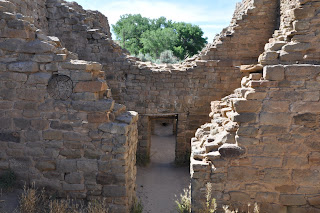 After leaving Grand Canyon, it was over an hour drive to connect to highway 89 at Cameron and the location for the Junction Campground.
After leaving Grand Canyon, it was over an hour drive to connect to highway 89 at Cameron and the location for the Junction Campground.In retrospect it would have been wise to check out the campground to at least find if they had tent sites available; but, there was still daylight and I remembered talking with fellow bikers who had mentioned that they were going to Tuba City. It wasn't as if they had talked in glowing terms about Tuba City, but nonetheless, I felt almost compelled to go there - it was a mistake. The Junction Campground had been right on the highway, but Tuba City was twelve miles east of highway 89 (why must I make things so difficult?)
Actually, the campground at Tuba City (part of Quality Inn) was clean, neat and reasonably priced. It had one minor problem though, Tuba City is part of the Navajo Nation and thus the sale if alcohol is prohibited - I just wanted a beer, but that was not to be.
Page, Arizona was my next stop; located just to the south of the Utah border and the site of the beautiful Glen Canyon Dam. Actually, the city of Page was built in 1957 to house workers building the Glen Canyon Dam.
Today is Page is a progressive looking community without any of the remnants of a bygone past to contend with that haunt most cities. With only the present, the future and their short history to deal, they are the envy of many a community. The monstrous Lake Powell (the second largest man made lake on the United States - after Lake Mead) created by the dam - the Glen Canyon National Recreation Area is a recreational Mecca for American vacationers.
My plan for the day was to proceed north into Utah to Bryce Canyon National Park. It was only a four hour, 234 mile ride (according to Map Quest) that should have been no problem - if only I had kept gas in the tank!
 Just to the West of Page the highway crosses into Utah where Big Water is barely a blurb before beginning the 74 mile trek to Kanab, Utah. Obviously, with all of my past experiences I should have made sure that there was plenty of gas in the tank, but for whatever reason, I failed to so. Fifteen miles east of Kanab my Harley droned to a stop.
Just to the West of Page the highway crosses into Utah where Big Water is barely a blurb before beginning the 74 mile trek to Kanab, Utah. Obviously, with all of my past experiences I should have made sure that there was plenty of gas in the tank, but for whatever reason, I failed to so. Fifteen miles east of Kanab my Harley droned to a stop. There was little doubt as to the problem - I had been there before.
Highway 89, as the main road north from Flagstaff (and also the most direct route to Bryce Canyon), it is the favorite of RVer's and biker's alike - surely, someone would come to my aid.
However, everyone has there own agenda and I couldn't fault them for not stopping; but a lone biker on the side of the road, is seldom passed by other riders and I wasn't either.
A couple of European's, riding rented Honda's motorcycles out of Florida, stopped to offer their assistance and even offered to siphon gas from one of their tanks - but, no one had a hose.
One of them suggested I flag down a car. Left with few alternatives, I reluctantly agreed.
At first I tried attracting a truck pulling a boat, which would most likely have available gas, but to no avail.
Impatient, I tried to flag down anyone else who would stop.
I remembered how in my youth I had sometimes hitch-hiked and always met interesting people; it was like reliving the past when a man in his 40's stopped to assist. He didn't have any gas or a hose (anyway, the bikers had since departed), but offered to take me to Kanab. He told me that he had traveled these roads years before, when as a college student he (twice) "walked" from Provo to Flagstaff (a "short" month long hike).
At the Kanab Phillips 66 station, were he dropped me off, I secured a gallon of gas and trudged, gas can in hand, back to highway; feeling quite foolish (as well I should have).
I was comforted by the feeling that, "this hopeless looking sole" standing along side the highway in swelter heat would certainly stir someone's compassion; but most of the traffic was going north or turned at the gas station short of my location.

Even so, less than fifteen passed, before I was picked up by a young girl returning home from work.
Donna had her own set of problems, but she none the less was kind enough to concern herself with mine.
Her "middle-aged" pickup truck had vice-grips locked in two places around the steering column (one as a pseudo gear shift and the other serving some unknown function). She advised me that the air conditioner didn't work and when I asked for her permission to roll down the window, she replied - "that doesn't work either!" And she stopped to help me!
Donna said that she worked at the grocery store in town and lived just five miles east of Kanab. My Harley still waited for my return, fifteen miles to the east. None the less, Donna drove without hesitation the back to my Harley, and at first refused to accept my paltry offer of $10. She relented when I advised her that, "that will at least pay for your gas." Bless you Donna.


















































